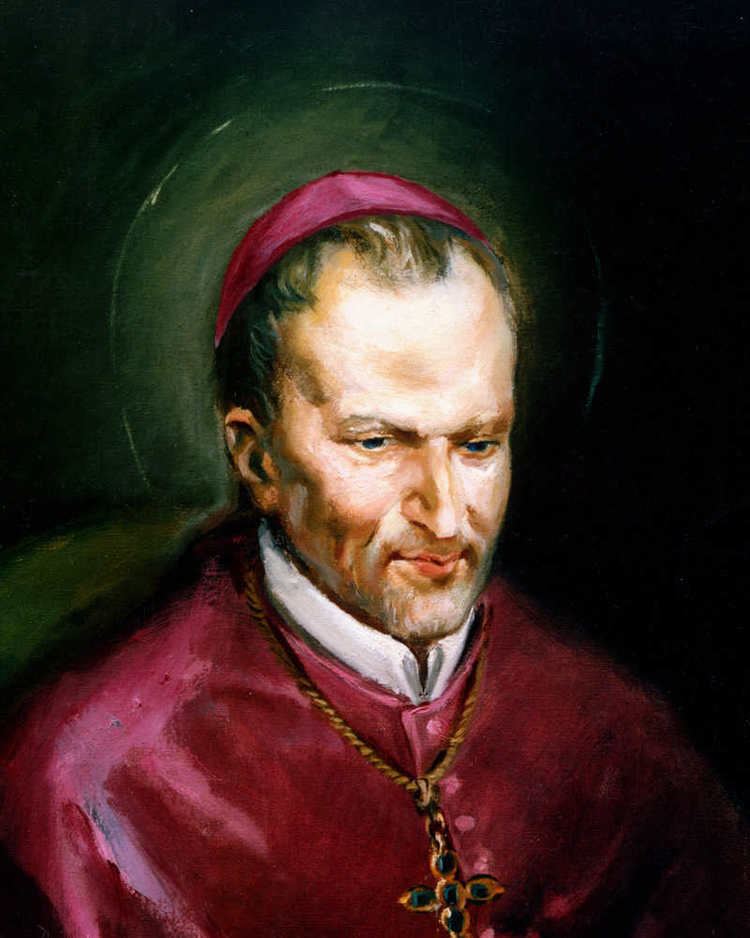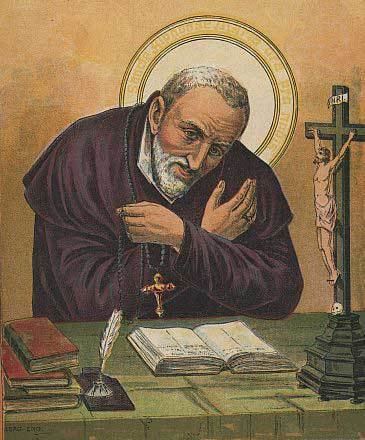Metropolis Benevento See Sant'Agata de' Goti Installed 20 June 1762 Name Alphonsus de' | Diocese Sant'Agata de' Goti Appointed 14 June 1762 Term ended 26 June 1775 Role Writer | |
Died August 1, 1787, Pagani, Italy Education University of Naples Federico II Parents Anna Cavalieri Liguori, Don Joseph de' Liguori Organizations founded Congregation of the Most Holy Redeemer Books The Glories of Mary, The True Spouse of Jesus Ch, Dignity and duties of the priest, The passion and the d, The Twelve Steps to Holiness Similar People Pope Pius IX, Pope Leo XIII, Mother Teresa, Josefa Menendez, Bernhard Haring | ||
Alphonsus maria de liguori
Saint Alphonsus Maria de' Liguori, C.Ss.R. (27 September 1696 – 1 August 1787), was an Italian Catholic bishop, spiritual writer, composer, musician, artist, poet, lawyer, scholastic philosopher, and theologian.
Contents
- Alphonsus maria de liguori
- Early years
- Education
- Career change
- Congregation of the Most Holy Redeemer
- Bishop
- Death
- Veneration and legacy
- Overview
- Moral theology
- Mariology
- Other works
- References
He founded the Congregation of the Most Holy Redeemer (the Redemptorists). In 1762 he was appointed Bishop of Sant'Agata dei Goti. A prolific writer, he published nine editions of his Moral Theology in his lifetime, in addition to other devotional and ascetic works and letters. Among his best known works are The Glories of Mary and The Way of the Cross, the latter still used in parishes during Lenten devotions.

He was canonized in 1839 by Pope Gregory XVI. Pope Pius IX proclaimed him a Doctor of the Church in 1871. One of the most widely read Catholic authors, Alphonsus Ligouri is the patron saint of confessors.

Early years

Alphonsus Maria de' Liguori was born in Marianella, near Naples, then part of the Kingdom of Naples. He was the eldest of eight children of Giuseppe and Anna Cavalieri Liguori. Two days after he was born he was baptized at the Church of Our Lady the Virgin as Alphonsus Mary Anthony John Cosmas Damian Michael Gaspard de' Liguori. The family was an old and noble one, though the branch to which the Saint belonged had become somewhat impoverished. Alphonsus's father, Don Joseph de' Liguori was a naval officer and Captain of the Royal Galleys. His mother was of Spanish descent.
Education
Liguori learned to ride and fence, but was never a good shot due to poor eyesight. Myopia and chronic asthma precluded a military career, so his father had him educated for the legal profession. He was taught by tutors before entering the University of Naples, where he graduated with doctorates in civil and canon law at age sixteen. He remarked later that he was so small at the time as to be almost buried in his doctor's gown and that all the spectators laughed. He became a successful lawyer. He was thinking of leaving the profession, and wrote to someone: "My friend, our profession is too full of difficulties and dangers; we lead an unhappy life and run risk of dying an unhappy death." At the age of twenty-seven, after having lost an important case—the first he had lost in eight years of practicing law—he made a firm resolution to leave the profession of law. Moreover, he heard an interior voice, saying: "Leave the world, and give yourself to me."
Career change
In 1723, he decided to offer himself as a novice to the Oratory of St. Philip Neri with the intention of becoming a priest. His father opposed this plan, but after two months (and with his Oratorian confessor's permission), he and his father compromised: he would study for the priesthood, but not as an Oratorian and while living at home. He was ordained on 21 December 1726, at the age of 30. He lived his first years as a priest with the homeless and marginalized youth of Naples. He became very popular because of his plain and simple preaching. He said: "I have never preached a sermon which the poorest old woman in the congregation could not understand." He founded the Evening Chapels which were managed by the young people themselves. These chapels were centers of prayer and piety, preaching, community, social activities, and education. At the time of his death, there were 72 of these chapels with over 10,000 active participants. His sermons were very effective at converting those who were alienated from their faith.
Liguori suffered from scruples much of his adult life, and felt guilt about the most minor issues relating to sin. Moreover, the saint viewed scruples as a blessing at times, he wrote: "Scruples are useful in the beginning of conversion....they cleanse the soul, and at the same time make it careful".
In 1729, Alphonsus left his family home and took up residence in the Chinese Institute in Naples. It was there that he began his missionary experience in the interior regions of the Kingdom of Naples where he found people who were much poorer and more abandoned than any of the street children in Naples. In 1731, while ministering to earthquake victims in the town of Foggia, Alphonsus claimed to have had a vision of the Virgin Mother in the appearance of a young girl of thirteen or fourteen, wearing a white veil.
Congregation of the Most Holy Redeemer
On 9 November 1732, Alphonsus founded the Congregation of the Most Holy Redeemer, when Sister Maria Celeste Crostarosa told him that it had been revealed to her that he was the one God had chosen to found the congregation. He founded the congregation with the charism of preaching popular missions in the city and the countryside. Its goal was to teach and preach in the slums of cities and other poor places. They also fought Jansenism–a heresy that supported a very strict morality–declaring that "the penitents should be treated as souls to be saved rather than as criminals to be punished." He is said never to have refused absolution to a penitent.
Bishop
Alphonsus was consecrated Bishop of Sant'Agata dei Goti in 1762. He tried to refuse the appointment, proposing his age and infirmities as arguments against his consecration. During this time he wrote sermons, books, and articles to encourage devotion to the Blessed Sacrament and the Blessed Virgin Mary. His first order of business was to address ecclesiastical abuses in the diocese, reform the seminary and spiritually rehabilitate the clergy and faithful. He suspended those priests who celebrated Mass in less than 15 minutes, and sold his carriage and episcopal ring in order to give the money to the poor. In the last years of his life, he suffered a painful sickness and a bitter persecution from his fellow priests, who dismissed him from the Congregation he himself had founded.
Death
In 1775, he was allowed to retire from his office and went to live in the Redemptorist community in Pagani, Italy, where he died on 1 August 1787.
Veneration and legacy
Alphonsus Liguori was beatified on 15 September 1816 by Pope Pius VII and canonized on 26 May 1839 by Pope Gregory XVI.
In 1949, the Redemptorists founded the Alphonsian Academy for the advanced study of Catholic moral theology. He was named patron of confessors and moral theologians by Pope Pius XII on 26 April 1950, who subsequently wrote of him in the encyclical Haurietis aquas.
Overview
Alphonsus was a prolific and popular author. He was proficient in the arts, his parents having had him trained by various masters, and was a musician, painter, poet, and author at the same time. Alphonsus wrote 111 works on spirituality and theology. The 21,500 editions and the translations into 72 languages that his works have undergone attest to the fact that he is one of the most widely read Catholic authors.
His best known musical work is his Christmas hymn Quanno Nascetti Ninno, later translated into Italian by Pope Pius IX as Tu scendi dalle stelle ("From Starry Skies Thou Comest").
Moral theology
Alphonsus' greatest contribution to the Church was in the area of moral theology. His masterpiece was The Moral Theology (1748), which was approved by the Pope himself. This was born of Alphonsus' pastoral experience, his ability to respond to the practical questions posed by the faithful and from his contact with their everyday problems. He opposed sterile legalism and strict rigorism. According to Alphonsus, those were paths closed to the Gospel because "such rigor has never been taught nor practiced by the Church". His system of moral theology is noted for its prudence, avoiding both laxism and excessive rigor. He is credited with the position of Aequiprobabilism, which avoided Jansenist rigorism as well as laxism and simple probabilism.
Mariology
His Mariology, though mainly pastoral in nature, rediscovered, integrated and defended the Mariology of Saint Augustine and Saint Ambrose and other fathers and represented an intellectual defence of Mariology in the 18th century, the Age of Enlightenment, against the rationalism to which his often flaming Marian enthusiasm contrasted.
